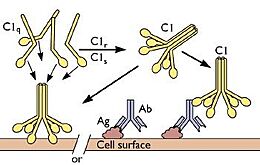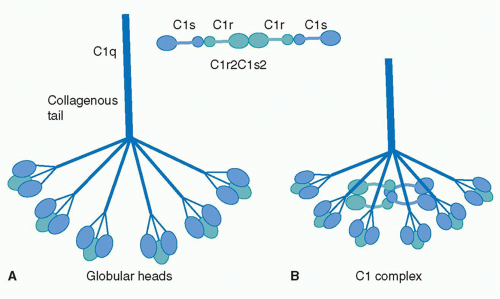User:Matthew Chien/Sandbox 1
From Proteopedia
(Difference between revisions)
| Line 10: | Line 10: | ||
C1q plays a major role in the innate part of the immune system. It is the first complement protein to be activated in the classical complement pathway. This pathway of complement activation is dependent on the detection of antibody-antigen complexes, which creates a cascade of complement protein activation to ultimately promote inflammation, enhance the performance of various immune cells, and attack the pathogen's cell membrane. This acts as an irreplicable aspect of the innate immune system and is one of the body's primary defense against invaders. | C1q plays a major role in the innate part of the immune system. It is the first complement protein to be activated in the classical complement pathway. This pathway of complement activation is dependent on the detection of antibody-antigen complexes, which creates a cascade of complement protein activation to ultimately promote inflammation, enhance the performance of various immune cells, and attack the pathogen's cell membrane. This acts as an irreplicable aspect of the innate immune system and is one of the body's primary defense against invaders. | ||
| - | C1q is also known to be a kind of opsonin, which is a protein that tags a foreign cell to be engulfed and destroyed by phagocytes, such as neutrophils and macrophages. This process is a very important aspect of the innate immune system to eliminate foreign bacteria and viruses to keep the host healthy. It has been shown that both neutrophils and macrophages posses receptors capable of binding the globular head and CLR of C1q, named gC1q and cC1q respectively, emphasizing their crucial role for phagocytes to identify and eliminate foreign pathogens. Immature dendritic cells have also been shown to contain a large amounts of gC1q and cC1q. This acts as an important bridge between the innate and adaptive immune systems; dendritic cells can survey certain areas based on the amount of present C1q in order to activate and begin digesting antigens to present to T-cells, which is a crucial step in adaptive immunity activation. | + | C1q is also known to be a kind of opsonin, which is a protein that tags a foreign cell to be engulfed and destroyed by phagocytes, such as neutrophils and macrophages. This process is a very important aspect of the innate immune system to eliminate foreign bacteria and viruses to keep the host healthy. It has been shown that both neutrophils and macrophages posses receptors capable of binding the globular head and CLR of C1q, named gC1q and cC1q respectively, emphasizing their crucial role for phagocytes to identify and eliminate foreign pathogens. Immature dendritic cells have also been shown to contain a large amounts of gC1q and cC1q. This acts as an important bridge between the innate and adaptive immune systems; dendritic cells can survey certain areas based on the amount of present C1q in order to activate and begin digesting antigens to present to T-cells, which is a crucial step in adaptive immunity activation. <ref>PMID:29692784</ref><ref>PMID:15388251</ref><ref>Janeway CA Jr, Travers P, Walport M, et al. Immunobiology: The Immune System in Health and Disease. 5th edition. New York: Garland Science; 2001. The complement system and innate immunity. Available from: https://www.ncbi.nlm.nih.gov/books/NBK27100/</ref><ref>PMID:9407113</ref><ref>PMID:15982298</ref><ref>PMID:28104818</ref> |
=== Adaptive Immunity === | === Adaptive Immunity === | ||
Revision as of 12:53, 28 April 2025
| |||||||||||
References
- ↑ Reid KBM. Complement Component C1q: Historical Perspective of a Functionally Versatile, and Structurally Unusual, Serum Protein. Front Immunol. 2018 Apr 10;9:764. PMID:29692784 doi:10.3389/fimmu.2018.00764
- ↑ Janeway CA Jr, Travers P, Walport M, et al. Immunobiology: The Immune System in Health and Disease. 5th edition. New York: Garland Science; 2001. The complement system and innate immunity. Available from: https://www.ncbi.nlm.nih.gov/books/NBK27100/
- ↑ Kishore U, Ghai R, Greenhough TJ, Shrive AK, Bonifati DM, Gadjeva MG, Waters P, Kojouharova MS, Chakraborty T, Agrawal A. Structural and functional anatomy of the globular domain of complement protein C1q. Immunol Lett. 2004 Sep;95(2):113-28. PMID:15388251 doi:10.1016/j.imlet.2004.06.015
- ↑ Reid KBM. Complement Component C1q: Historical Perspective of a Functionally Versatile, and Structurally Unusual, Serum Protein. Front Immunol. 2018 Apr 10;9:764. PMID:29692784 doi:10.3389/fimmu.2018.00764
- ↑ Kishore U, Ghai R, Greenhough TJ, Shrive AK, Bonifati DM, Gadjeva MG, Waters P, Kojouharova MS, Chakraborty T, Agrawal A. Structural and functional anatomy of the globular domain of complement protein C1q. Immunol Lett. 2004 Sep;95(2):113-28. PMID:15388251 doi:10.1016/j.imlet.2004.06.015
- ↑ Janeway CA Jr, Travers P, Walport M, et al. Immunobiology: The Immune System in Health and Disease. 5th edition. New York: Garland Science; 2001. The complement system and innate immunity. Available from: https://www.ncbi.nlm.nih.gov/books/NBK27100/
- ↑ Kaul M, Loos M. Dissection of C1q capability of interacting with IgG. Time-dependent formation of a tight and only partly reversible association. J Biol Chem. 1997 Dec 26;272(52):33234-44. PMID:9407113 doi:10.1074/jbc.272.52.33234
- ↑ Sontheimer RD, Racila E, Racila DM. C1q: its functions within the innate and adaptive immune responses and its role in lupus autoimmunity. J Invest Dermatol. 2005 Jul;125(1):14-23. PMID:15982298 doi:10.1111/j.0022-202X.2005.23673.x
- ↑ Mortensen SA, Sander B, Jensen RK, Pedersen JS, Golas MM, Jensenius JC, Hansen AG, Thiel S, Andersen GR. Structure and activation of C1, the complex initiating the classical pathway of the complement cascade. Proc Natl Acad Sci U S A. 2017 Jan 31;114(5):986-991. PMID:28104818 doi:10.1073/pnas.1616998114


